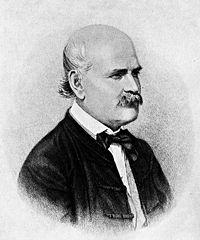Ignaz Philipp Semmelweis(July 1, 1818–August 13, 1865) (born Ignác Fülöp Semmelweis) was a Hungarian physician now known as an early pioneer of antiseptic procedures. Described as the "savior of mothers",Semmelweis discovered that the incidence of puerperal fever could be drastically cut by the use of hand disinfection in obstetrical clinics.Puerperal fever was common in mid-19th-century hospitals and often fatal, with mortality at 10%–35%. Semmelweis postulated the theory of washing with chlorinated lime solutions in 1847 while working in Vienna General Hospital's First Obstetrical Clinic, where doctors' wards had three times the mortality of midwives' wards. He published a book of his findings in Etiology, Concept and Prophylaxis of Childbed Fever.
Despite various publications of results where hand-washing reduced mortality to below 1%, Semmelweis's observations conflicted with the established scientific and medical opinions of the time and his ideas were rejected by the medical community. Some doctors were offended at the suggestion that they should wash their hands and Semmelweis could offer no acceptable scientific explanation for his findings. Semmelweis's practice earned widespread acceptance only years after his death, when Louis Pasteur confirmed the germ theory and Joseph Lister practiced and operated, using hygienic methods, with great success. In 1865, Semmelweis was committed to an asylum, where he died, ironically, of septicemia at age 47.
http://en.wikipedia.org/wiki/Ignaz_Semmelweis
http://hu.wikipedia.org/wiki/Semmelweis_Ign%C3%A1c
Ignaz Philipp Semmelweis: "A gyermekágyi láz kóroktana" ("The Etiology of Childbed Fever") published in Orvosi hetilap 2 (1858)
Ignaz Philipp Semmelweis: "A gyermekágyi láz fölötti véleménykülönbség köztem s az angol orvosok közt" Orvosi hetilap 4 (1860), 849–851, 873-76, 889–893, 913–915.
